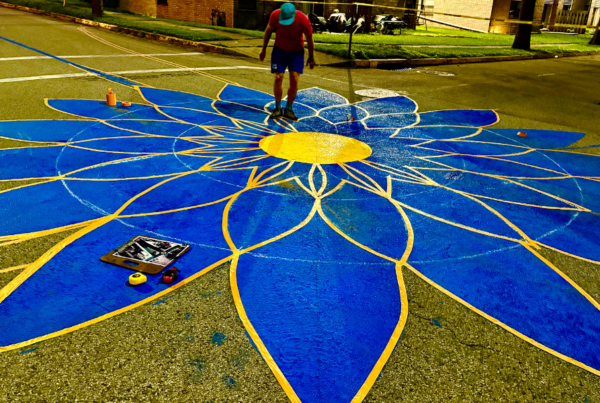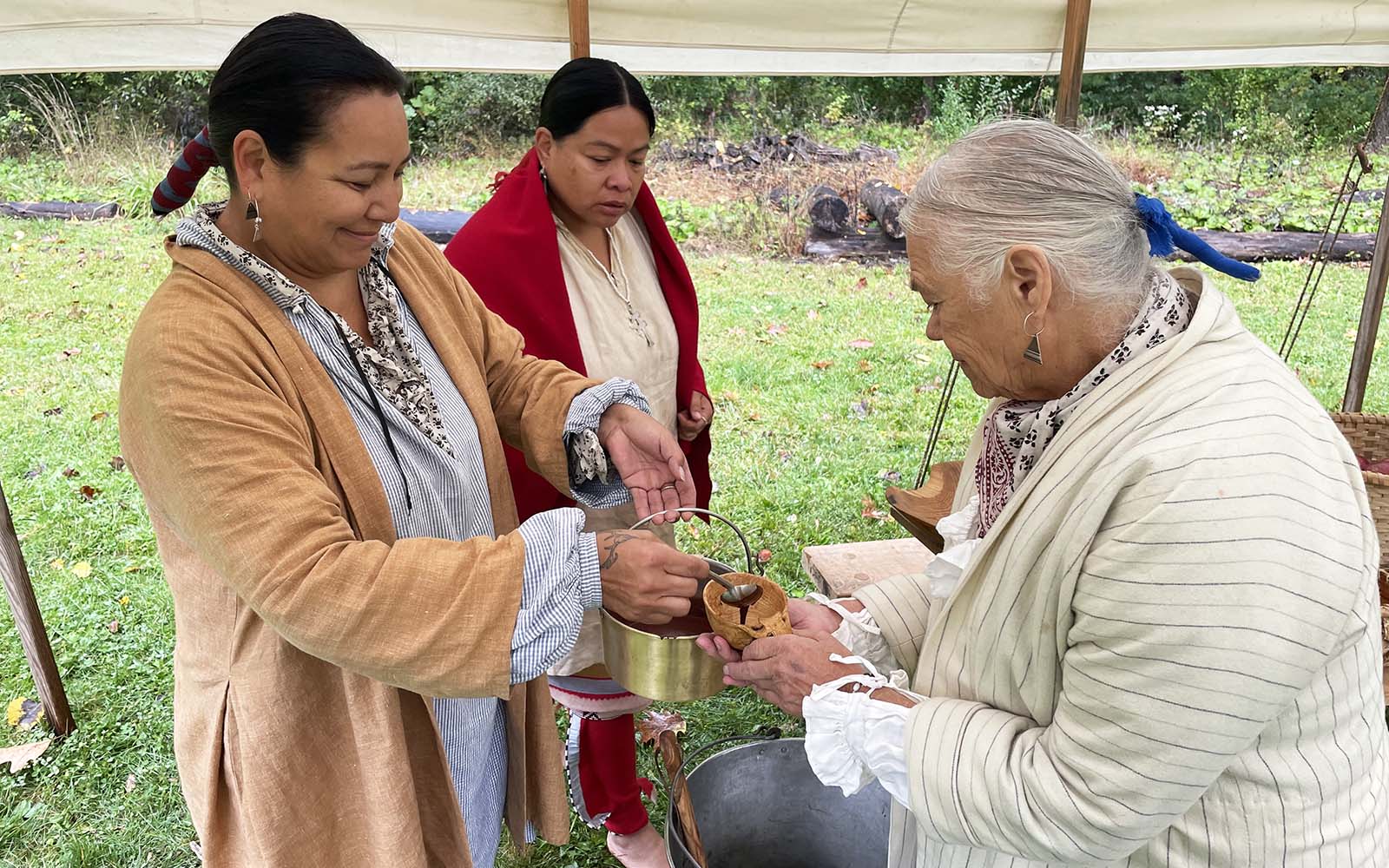
“Life with a Shawnee Family” at Meadowcroft.
Community Spotlight—Meadowcroft Rockshelter and Historic Village and Fort Pitt Museum
The Community Spotlight series features the efforts Rivers of Steel’s partner organizations, along with collaborative partnerships, that reflect the diversity and vibrancy of the communities within the Rivers of Steel National Heritage Area.
By Gita Michulka, Contributing Writer
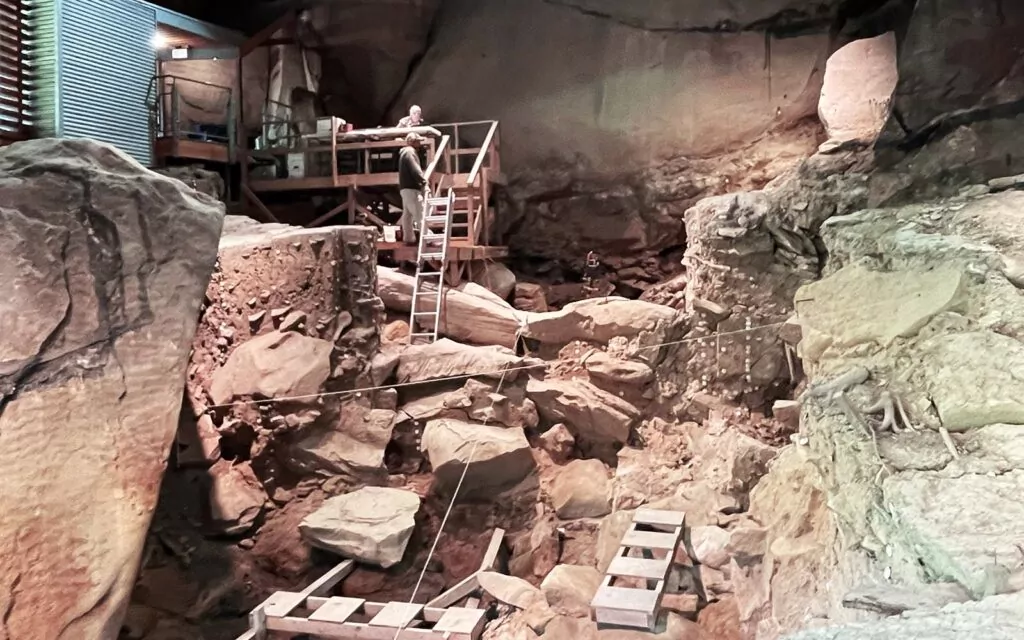
The Meadowcroft Rockshelter
Amplifying Historic Voices of Western Pennsylvania
Taking an authentic look back in time over 400 years has a deeper meaning when you can hear directly from descendants of the people who lived in this region during that time. New fall programming at Meadowcroft Rockshelter and Historic Village and the Fort Pitt Museum aims to amplify the perspectives of native tribes within the historic stories that shape western Pennsylvania.
Meadowcroft recently hosted Life with a Shawnee Family, a two-day event where ten members of federally recognized American Indian tribes traveled to western Pennsylvania to participate in recreations throughout the site.
Visitors at Meadowcroft, a 275-acre site in Washington County, have a unique ability to travel through several distinct periods of time. The Rockshelter, a National Historic Landmark, houses the earliest known campsite in North America, with signs of life dating from 19,000 years ago. Nearby, there are three other outdoor historic areas: a sixteenth-century Monongahela Indian Village that looks at life after agriculture but prior to European settlement; an eighteenth-century frontier trading post; and a nineteenth-century rural village, which includes a single-family home, a one-room schoolhouse, a blacksmith shop, and a covered bridge.
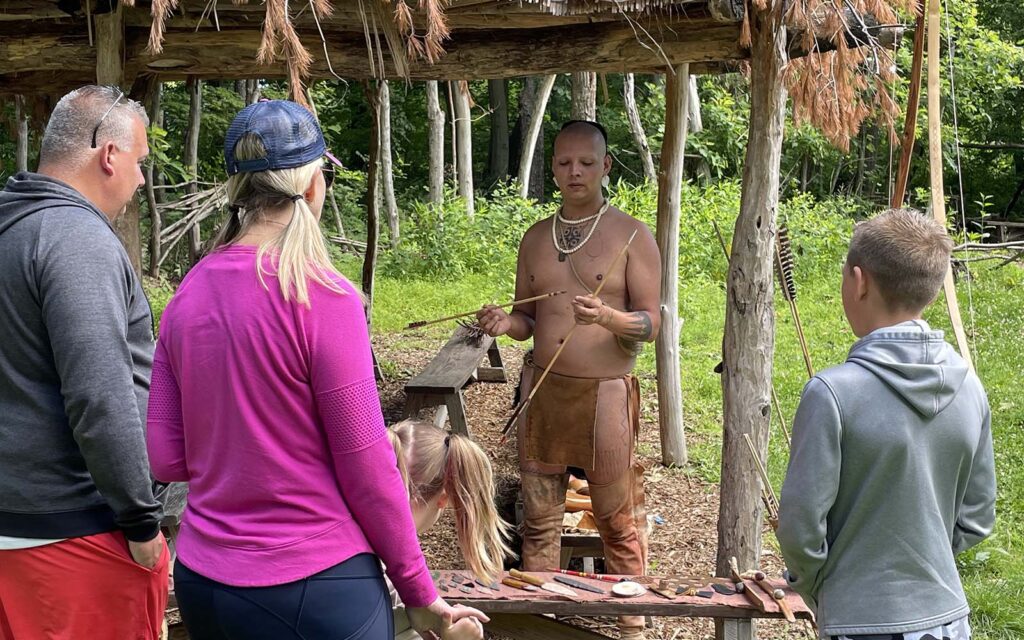
The “Life with a Shawnee Family” event.
For the Life with a Shawnee Family event, the focus in each of these areas across Meadowcroft was a historical interpretation from an American Indian tribe’s perspective. Tribal members were located in the Monongahela Indian Village to talk about pre-contact life and in the eighteenth century frontier area to talk about life during that period. The program also aimed to offer a native perspective on the Indian Removal Act of 1830 and the effect it had on the indigenous people. Across the site, members of the tribe also offered visitors a chance to see how tasks were performed by their ancestors in the early days of agriculture and how Ohio Valley tribes lived off the land.
“One of the major initiatives that we’re partnering with the Fort Pitt staff on is what we’re calling our American Indian initiative,” says David Scofield, Director of Meadowcroft Rockshelter and Historic Village. “We’re developing relationships with the tribes that were here historically but were forcibly removed and pushed west to reservations in Kansas and Oklahoma or north to New York. The Shawnee tribes, the Delaware tribes, Seneca, and the Seneca-Cayuga.”
Scofield continues, “Our goal is to involve those tribes that were here historically as we develop programming and we develop exhibits so that they can have a voice here once again in a place where they no longer have a physical presence but were a major part of our region’s history.”
At the Fort Pitt Museum, the timeline picks up where Meadowcroft leaves off, highlighting the mid-to-late eighteenth-century wars that further shaped our region. Displays in the museum showcase Pittsburgh’s pivotal role in the French and Indian War and the American Revolution and also what life was like in the early days as the city was developing.
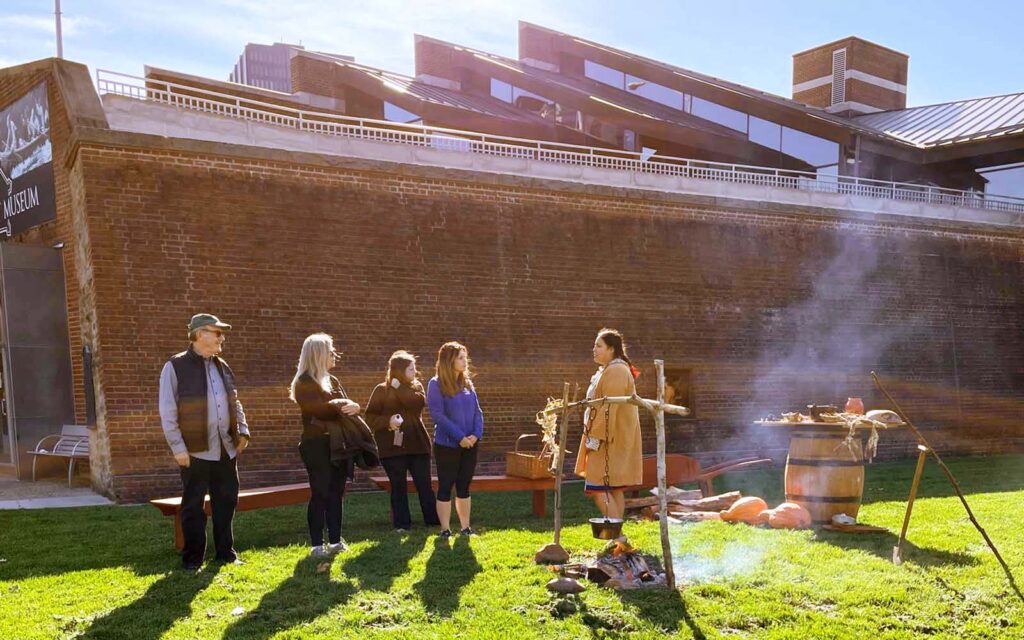
Cooking demonstration at the Fort Pitt Museum.
A recent program at Fort Pitt also highlighted the interactions between the historic tribes that once called Pittsburgh home, including a cooking demonstration from Shideezhi Emarthla, a citizen of the Seneca-Cayuga Nation. The program was held on the museum lawn in Point State Park and was free to the public.
Additionally, the Fort Pitt Museum has opened a new exhibit titled Guyasuta: The Life & Legend of a Seneca Chief. The exhibit looks at the life of one of Pittsburgh’s eighteenth-century leaders and includes the bronze scale model for the “Points of View” sculpture on Mount Washington by local sculptor Jim West.
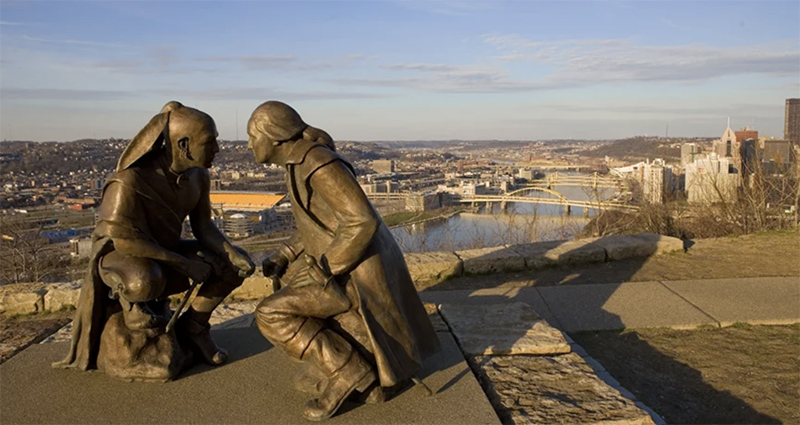
Point of View sculpture on Mount Washington, courtesy of Jim West.
The effect of physically being at these historical sites is never lost on Justin Meinert, education and living history manager at the Fort Pitt Museum. “At Fort Pitt you get to experience the historical significance of Point State Park and be in the atmosphere of downtown Pittsburgh,” he says. “While at Meadowcroft, you are standing in a historically significant spot of 19,000 years of human inhabitation, and for a slight moment may be able to feel as if you are in a 1620s Monongahela Indian Village or eighteenth-century town—and all the while you are surrounded by the best views Western Pennsylvania’s countryside has to offer.”
“By implementing American Indian Programing—mainly living history programs—at both sites, it allows not only a large, diverse visitor base to experience the programs, but our presenters themselves,” says Meinert.
Scofield agrees. “Because of our American Indian initiative, we have cooperated in both directions where, you know, Fort Pitt staff will come here and help us with programming, and then we’ve participated in programs there as well,” he says. “So we’ve been doing that a little bit, but this is a growing initiative, and I expect a lot more of that over time.”
Life with a Shawnee Family and these recent programs at Fort Pitt were funded in part by the Rivers of Steel Mini-Grant Program. Meadowcroft Rockshelter and Historic Village and the Fort Pitt Museum are part of the Senator John Heinz History Center, a Smithsonian affiliate that also houses the Western Pennsylvania Sports Museum and the Detre Library and Archives.
Upcoming fall programming at Meadowcroft includes Archaeology Day, in partnership with the Society for Pennsylvania Archaeology; Insider Tours of the Rockshelter with James M. Adovasio, Ph.D., lead archaeologist on the site; and a Taffy Pull and Fall Finale. Visit heinzhistorycenter.org/Meadowcroft for details. The Fort Pitt Museum offers both guided and self-guided tours that meet the needs of a variety of audiences. For a listing of exhibits and events, visit heinzhistorycenter.org/fort-pitt.
All images courtesy of Meadowcroft Rockshelter and Historic Village and Fort Pitt Museum, except where noted.
About the Mini-Grant Program
Rivers of Steel’s Mini-Grant Program assists heritage-related sites and organizations as well as municipalities within the Rivers of Steel National Heritage Area to develop new and innovative programs, partnerships, exhibits, tours, and other initiatives. Funded projects support heritage tourism, enhance preservation efforts, involve the stewardship of natural resources, encourage outdoor recreation, and include collaborative partnerships. Through these efforts, Rivers of Steel seeks to identify, conserve, promote, and interpret the industrial and cultural heritage that defines southwestern Pennsylvania.
The Rivers of Steel National Heritage Area is one of twelve supported by the Pennsylvania Department of Conservation and Natural Resources (DCNR). Funding is provided via DCNR’s Community Conservation Partnerships Program and the Environmental Stewardship Fund to Rivers of Steel, which administers the Mini-Grant Program. Meadowcroft Rockshelter and Historic Village and Fort Pitt Museum is one of eight organizations who received Mini-Grant funding through this program in 2022.
 Gita Michulka is a Pittsburgh-based marketing and communications consultant with over 15 years of experience promoting our region’s arts, recreation, and nonprofit assets.
Gita Michulka is a Pittsburgh-based marketing and communications consultant with over 15 years of experience promoting our region’s arts, recreation, and nonprofit assets.
If you’d like to know more about community projects supported by the Mini-Grant Program, read Gita’s recent article about the West Overton Village and Museums.



